Mercury Marine’s Verado Engine is an engine that has changed the way outboard engines are viewed. As well as helped fuel the crave for massive center console boats that will do 60+ MPH! Which makes people wonder:
What problems do Mercury Verado’s have?
- The Oil Squirting & Time Jumping
- The Shift Crank Sticking
- Isolator & MAP Boot Tearing
- Back pressure Blow Out
- 4.83 Lower Unit
- Powerhead Oil Pump Leaking
- Ignition Coil Failure
- Sticky Float Switches
- Trim Sender Failure
- The SCI Confusion
This will be all the information that you need to know about what problems Mercury Verado Engines have had, through the years.
The Oil Squirting & Time Jumping Hold Up
In the early years, when the Verado was first put on the market, in late 2004/2005, the block design it had was called “oil squirters”. These squirters would squirt oil on the back of the pistons to further lubricate the cylinders.
It wasn’t long after that we all found out, the design of that block, restricted the actual engine’s horsepower. Which is why they only came out with up to 275 HP engines. That is because 275 was the maximum HP that the block could produce. No matter what PCM you put on it.
Slap a 400 PCM on that block, and at best you will get, 290 HP! It’s just the mechanical aspect of that block that restricts it from producing any more ponies (we’ll talk a little later about the 350 SCI that came out with this design)
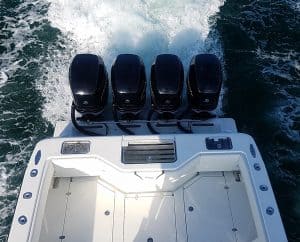 One of the main problems of that block was, over time, the engine would jump timing. Being that the engine is an interference motor, once it jumps time, it can smash the valves to pieces and be nothing more than a really good anchor!
One of the main problems of that block was, over time, the engine would jump timing. Being that the engine is an interference motor, once it jumps time, it can smash the valves to pieces and be nothing more than a really good anchor!
What is an “interference engine”, you ask? Just a fancy way of saying that when the pistons come up, the valves go down. If the timing is incorrect by more than 1 tooth, then the pistons can come up and smash the valves down, destroying the engine!
The Verado runs on a timing chain, which makes for a great, maintenance-free valve train. So if these early design blocks jump timing, it could be a serious issue. Unless it only jumps a single tooth. Then the timing chain could be put back on and get the engine back in time without any issues.
One other problem that was common for these engines was that they would lose compression on the bottom two cylinders! As time went on, compression would slowly drop on cylinders 5 & 6, causing serious problems.
These problems were common during the transitional phase of the Verado Evolution, from 2004-2007. Around 2008 the Design II came out and all of these issues had been resolved.
(Note that if you run an engine at wide-open throttle and go directly back into reverse, the motion of the boat and the propeller can cause the engine to jump timing. You can also blow up the lower unit. Even worse, a wave of water can come up over the engine and suck in water through the exhaust, blowing up the powerhead!
Here is an article that we wrote on What Exactly Is An Outboard Powerhead!
Never “chop the throttles”! Pay close attention to your surroundings and your heading.)
The Shift Crank Sticker
Another problem that was going on during those first few flagship years of the Mercury Verado is that the bell crank would seize up and stick; leaving you unable to control the shifting of the engine!
Fixing this issue required the unbolting of the engine mounts and pushing the engine up out of the cradle mount to change out the bell crank that attached to the shift shaft going down to the lower unit.
This was a common problem, but during the early years of the engine, it didn’t take long for the issue to arise and quickly be resolved.
Mercury put out an immediate service bulletin and warranty claim for all of the serial numbers that were affected by this problem.
Thankfully, because of their quick action and the lifetime warranty claim for the issue, the problem was mostly resolved. Being 2018 almost 2019, at the time of this article, there are very few, if any, engines left out on the market that still has this problem.
Isolator & Map Sensor Boot Rippers
Moving up into the production years, there was one extremely well-known issue. Along with a little lesser-known, but still a very common problem, with the Throttle body and MAP sensor boots.
One of the most common problems is that there was a long period of time where the “Isolator Boot”, or the rubber boot that connects the Electronic Throttle Control unit to the bottom of the supercharger, would tear at the bottom, allowing an air leak to the supercharger.
This air leak would allow the supercharger to suck up a whole bunch of air and cause the engine to rev up in RPM’s. You would notice a higher than normal idle, or an extremely high idle. While at the same time hearing a loud hissing sound coming from the engine.
This was a simple fix, by just replacing the boot. Then quite a few years ago now, I want to say about 4 or 5 years, but I could be wrong. They changed the design of the boot. It is completely attached to the base of it and no longer separates, allowing the air leak.
As time goes on we see fewer and fewer issues with this particular problem. We see more the issue with the hose clamp that attaches it to the bottom of the supercharger. Where the hose clamp can rust and break, allowing the whole throttle body to drop off the bottom of the supercharger.
Of course, these problems take time and use, so they aren’t something that should trouble you too much. They are simple fixes and they don’t cause any damage to the engine. Just a matter of a hose clamp on a boat getting rusty. Who would have thought that would happen?
The lesser-known issue was the Manifold Absolute Pressure Sensor that is located on the top of the intake manifold.
This boot, when the engines first came out, was sticking straight up in the air! Over time, with the normal shock of cruising over waves, the boot would shake back and forth, eventually tearing.
Once the rubber boot tore, the engine would suck in a bunch of air and rev up again; causing the engine to not run at all, or run at such a high RPM it was ridiculous, if not downright scary if you didn’t know what was going on!
This ended up being another quick fix though. Mercury simply changed the design and put the sensor on a 45-degree angle. That’s it, problem resolved! That 45 degrees absorbed the shock and preserved the boot.
So, again this is another problem that is rare to find anymore.
Back Pressure Blow Outs To Wide Open Throttle
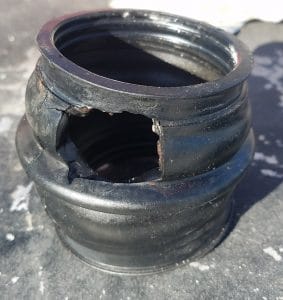 There is one more rubber hose that has been known to give some trouble. That is the tube that connects the supercharger to the Electronic Boost Controller and then one more that connected the boost controller to the “intake air cooler” (or just the intake manifold).
There is one more rubber hose that has been known to give some trouble. That is the tube that connects the supercharger to the Electronic Boost Controller and then one more that connected the boost controller to the “intake air cooler” (or just the intake manifold).
During certain loads, pressures, throttle chopping, or backfiring, it has been known to blow a hole right in the tube!
As soon as a hole gets in this though, the engine will basically suck in so much air that it will rev straight up, to almost wide open throttle! Again, a quick fix. Remove and replace the rubber tube and get back out on the water.
This “problem” just barely makes this list. Simply, because it is more of an operation and application problem than it is a “Mercury Verado Problem”. However, it is a problem that has been seen enough to warrant a good mention on our list here.
The 4.83 Lower Unit Beef Up
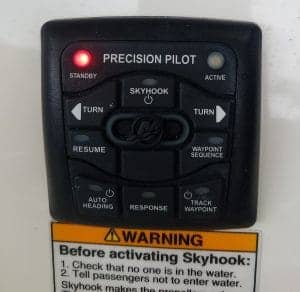 When the Verado first came out it was equipped with a 4.83-inch diameter gearcase. This gear case held up pretty well.
When the Verado first came out it was equipped with a 4.83-inch diameter gearcase. This gear case held up pretty well.
But over time as the engine got all its overhauls, more horsepower, and put on the back of bigger and bigger boats, it didn’t hold up as well.
The lower unit started to fail more and more often! Which was eventually changed in a couple of aspects, but basically beefed up to a 5.44-inch diameter gear case, which is solid as a rock! If not, one of the most solid gear cases that are on the market, at this point in time (2018).
The 4.83 gear case is not long forgotten though. It is actually a pretty desired lower unit. There are a lot of people out there that like to find these gear cases and buy them up. Then they slap them on a 400 HP engine on the back of a go-fast boat and run that gear case until it grenades like the 4th of July!
The smaller gearcase allows for less drag in the water and gets a couple more MPH’s, which in the go-fast world on the water, is a lot! But back to the listing of Verado Problems …
This gear case wasn’t really a “problem”, per se. It just wouldn’t have held up under the massive power of the huge center consoles that are now coming out. When you put a set of quad 300 HP Verados on the back of a 39′ center console with a 30′ tower, the 4.83 gear case just would not have held up.
Then, not to mention, with the soon coming Joystick Piloting for Outboards and skyhook, the beef up had to happen.
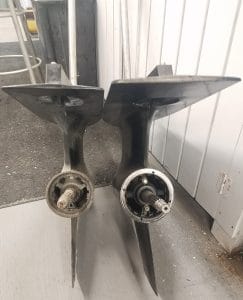 If you have ever seen or been around a boat with joystick piloting, you know those gear cases are working hard. Then to put them under the load of Skyhook; they are taking a massive beating during that experience.
If you have ever seen or been around a boat with joystick piloting, you know those gear cases are working hard. Then to put them under the load of Skyhook; they are taking a massive beating during that experience.
In order to hold up to offshore shifting and throttling every other second, fighting current and wind, the 5.44 gear case was necessary!
For those that don’t know what Skyhook is; Skyhook is basically where the Digital Throttle and Shift, using the Joystick Piloting System and GPS to control the engines.
Hook up to a spot via the GPS that you choose and controls the engines to hold the boat there in that spot, until, you turn it off or move the throttles to change positions.
It is actually quite a sight to see and the little 4.83 lower units, would just not have held up. Which is why they are on this list. Most Verados are now equipped with 5.44 gear cases, which is why the 4.83 are becoming a sought after hot commodity!
If you service your own lower unit, here is an article that we wrote and that you might find interesting. It goes into depth about What Color The Gear Lube Should Be and What It Means!
The Powerhead Oil Pump Leak Out
Again, going back to the earlier years. There are a couple of seals that are around the driveshaft which passes through the oil pump.
A quick lesson on the Verado. The driveshaft goes up, directly through the oil pump and the oil pan. The oil has to be drained out of the pan to remove the lower unit, otherwise, oil can be spilled all over the place, making a massive mess and creating an oily environmental hazard.
These seals would have a tendency to leak. When they leak, the oil will run down the driveshaft and over time, the engine will run low on oil. Which is a definite problem.
These seals can become a problem if service is not your thing (like on every single outboard out on the market). There can be build up around the seals; if regular service is not done, making it almost impossible to remove the lower unit. Then, times that by 10 when we are talking about saltwater!
Something that most people don’t realize is that when you buy a brand new engine, the factory does not grease anything.
(It’s also extremely important to properly Break In A Brand New Engine in order for it to have the longest life possible! This is an article we wrote that explains that process!)
So, even though we are now talking about a brand new engine, if the engine is not properly serviced, or the impeller is pushed off for 4-5 years; we are now running the risk of spending 8 hours, hammering and chiseling into the lower unit to wedge it off the driveshaft housing!
This can ultimately destroy a lot of components on the engine. We are talking about a 4-year-old engine that is now half-destroyed because of putting off removing the lower unit. Preventative maintenance is a big deal when it comes to getting it done in the early days of the engine, regardless of the brand of engine.
These seals that can get stuck and roll over, locking the driveshaft into the powerhead, which is not a good thing, is most assuredly a problem.
Again, now in 2018, we see fewer and fewer of these seals failing. Except when maintenance is just avoided like the plague! They hold up way better now than they used to.
Ignition Coil Cover Up
The all too common ignition coil intermittent failure. For about the first 4 years or so, the ignition coils had this cover on the back of them which identified the ones that were prone to fail.
These coils would sporadically fail, sometimes when they got hot. Sometimes when they were cold. Sometimes, they ran like a dream, not missing a lick.
These coils were phased out somewhere around 2008-2009. Which makes them a thing that you don’t see as often. But, are one of the top Verado problems that we’ve seen over the years.
The new style coils are holding up great. So just remember, if you look at the back of the ignition coil and there is what appears to be a black cap or cover; just know, that these could give you some intermittent running issues.
Lift Pump Time Out AKA Float Switch Stick Up
If you’ve noticed a trend here in this article, we keep talking about the “early years”. This is mainly because, in the first 5 years, most of all the problems that have been seen on the Verado were addressed and resolved. Making the Verado a battle-tested workhorse, giving an effortless experience in control, while on the water.
But in those early years, the Fuel Supply Module (FSM), ( <– This is an in-depth description of the FSM), contained a float switch. This float switch went through 2 different designs. The switch would stick in the up position, causing the lift pump to not turn on, running the engine out of fuel.
It’s also a good time to mention that for the first couple of years, primer bulbs and boat fuel filters were blacklisted for these engines. So when you ran out of fuel. Get out the paddle!
The float switch inside the FSM controls the level of fuel allowed into the container. When the switch goes to the top, it turns off the fuel lift pump.
Lift Pump Timeout was a common code, for when the float switch sticks in the down position, the lift pump will come on, pumping fuel, until it sees that float switch-hit that top position. Which, when it was stuck down, it never would. After a set period of time, the lift pump would turn off and let the operator know that the lift pump timed out.
After 2 designs of the float switch, the problem was resolved, for the most part! The problems are not catastrophic, but they still happen even with the new float design.
It takes a long period of time and a lot of hours, usually, before we start seeing any problems. But that is just part of the boating world.
The FSM was completely changed inside and out, somewhere around 2013ish. Mercury came out with an FSM design that eliminated the float switch all together! They installed tubing for cooling the fuel and just put the lift pump and high-pressure pump into the FSM.
The pumps run all the time when the engine is running. No more lift pump time out stick ups. (Here’s a video on How To Change Out That Float Switch!)
TRIM DOWN FOR WHAT!
Outboards these days are no longer the suck, bang, boom two strokes of yesteryears. These things are covered with sensors, which map out almost every single thing that you could think of seeing on a combustible engine.
It knows the timing, the air pressure, the outside air pressure, the manifold pressure, fuel pressure, temperature, oil temperature, hours, maintenance life, and much much more! It even knows the trim position of the engine. Which may or may not be a good thing.
Our next problem is dealing with that pesky trim sensor. The trim sensor lets the engine know where the engine is located in the trim range. It does this by a pin that spins a knob on the sensor as the engine trims up.
If this sensor fails and falsely tells the computer that the engine is trimmed all the way up, it will limit the RPM’s of the engine, so it won’t go over 4100 RPMs. But isn’t that the saying? Trim down for what!
This could be a tricky little problem that gets some people to scratch their heads. Landing itself on our list of Verado Problems. Again, it’s a simple fix. Remove and replace the sensor. You have probably noticed that when we get to the root of the problem on these engines, it’s remove and replace!
The design of the Verado is super simple when you get down to it. Everything is accessible and a huge portion of the problems can be fixed while the engine is in the water.
For all of you boaters out there like us, we leave our boats in the water all year round! Here’s some really helpful information that we wrote about How To Store Your Boat While In the Water, as well as What You Really Need To Know About Leaving A Boat In Saltwater!
With the two-piece cowling off, you can access anything on the engine.
Remove it and replace it. Getting the boat back in service and onto the next fishing spot!
About That Two-Piece Cowling
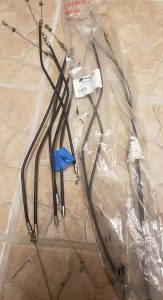 The only drawback to that cowling is a wetter engine inside.
The only drawback to that cowling is a wetter engine inside.
Remove that cowling, and on certain boats, you will see massive amounts of salt build up all over the motor. On the sides, on the front under the supercharger, all over the engine!
Which takes us to the next thing about that cowling. The cowling latches. These little latches utilize, basically, a bicycle brake cable to operate the latch. These are known for corroding around the latch and locking it in place. Or not locking it at all.
This becomes a problem when the top cowling gets stuck on the engine (Here’s a video on how to get that stuck cowling off). Luckily the engineers came up with a nice design to just remove the top 6 screws and undo the cable, allowing great access into the engine.
Which, with a little bit of washing, isn’t really that big of an issue. Don’t be afraid to remove the cowling of any outboard and give it a little bit of a washing. Cleaning off an engine doesn’t hurt it at all. Just don’t unplug stuff and stand there with the garden hose blasting the electrical components!
The Poor Little SCI That Thought He Could
Yes, the flippity floppity 350 SCI that only lasted a couple of years. This engine had quite a few problems!
We aren’t going to sit here and just bully the engine though. We need to just be thankful that Mercury saw the upcoming cliff and abandoned ship from this bad boy before things got really ugly.
They stopped production of this engine so fast, it’s almost hard to even find one anymore. They are out there, but they are a rarity. So if you can get your hands on one, it’s almost like a collector’s item at this point.
This engine was basically souped-up to the max and was just not stable because of it. It’s like taking a little truck and turning it into a big truck and expecting it to do big truck work, without breaking. It was just that poor little engine that thought he could…… But couldn’t!
The Mercury Verado Experience
 I’d like to end this on a good note! I hope this helps you out on your search for information on all of the problems that a Mercury Verado engine has. Yes, there are quite a few of them. But the thing that should be clear is that over the almost 15 years of service, the big bugs have been worked out of the engine.
I’d like to end this on a good note! I hope this helps you out on your search for information on all of the problems that a Mercury Verado engine has. Yes, there are quite a few of them. But the thing that should be clear is that over the almost 15 years of service, the big bugs have been worked out of the engine.
They are a solid motor and once someone drives a boat equipped with a Verado, it’s like you can never go back! It is an experience that has become the boating standard today. When these engines came out, they revolutionized the marine industry. Creating a standard so high, that it was hard for a lot of companies to catch up.
The marine industry has come a long way now and all manufacturers have adopted the fly by wire, digital layouts, and information-packed gauges. Driving a boat is now like getting into a luxury car and getting nice and comfy. In which, we all owe a good thank you to the standard that was set by the Mercury Verado and all its problems!
If you are looking into buying a new boat, we have some really in-depth information about What’s The Best Boat To Buy For You as well as Deciding Whether You Need An Inboard Boat or An Outboard Boat!
You might also find a ton of value here where break down whether or not Buying A Boat Is A Good or A Bad Investment!
Check Us Out!
Thank you for checking us out! We’d like to invite you to visit our YouTube Channel and watch some of our videos!
If you’ve got any questions or comments, let us know by subscribing to our YouTube Channel!
And if you would like to support us to continue bringing you great content, please click the link below to Amazon where we get a commission from anything you are already going to buy!
And you can also donate by clicking the donate button here or on the right hand of the screen!
It really helps us out and we thank you so much for your support!
We cover all kinds of boating, how-to, service, and outboard repair videos. And we cover all kinds of brands and boating installs, along with some re-power’s and restoration videos. Hopefully, you’ll get subscribed and join the Born Again Boating Family! Until next time, Have fun out on the water!

